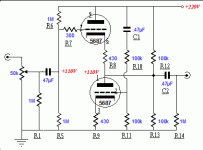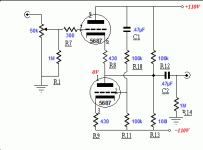Hi,
Ooopsie....Brain fart.
That'll teach me skipping the red anti-oxydants for too long....😉
Cheers, 😎
I thought PSRR was the whole point of JB's arrangement? Symmetry enforced in the first stage, power supply noise canceling in the second.
Ooopsie....Brain fart.

That'll teach me skipping the red anti-oxydants for too long....😉
Cheers, 😎
I've got one built (thanks to JB!) and it works as advertised.
Hey, it's 5am there? Brain farts allowed. Go get some sleep.
Hey, it's 5am there? Brain farts allowed. Go get some sleep.
Hi Frank,
Actually I already know what your answer would be about the regulation thingy and that's what I'm afraid of. 😀
But the Aikido has this martial arts inspired approach for psu noise i think.
Hi SY,
What tubes did you use? Did you regulate your psu? Or just a supply of freshly rectified, adequately filtered and clean DC is enough?
You see my problem is this:
My casing is already ready for painting, now if I will use a regulator then I will have to use either a mosfet or a hi voltage transistor referenced from a zener string (which a lot of guys here don't like). I will then have to make a plan for the ss regulator and drill more holes before I can paint the thing. This is giving me a headache!
I think I need a big
Actually I already know what your answer would be about the regulation thingy and that's what I'm afraid of. 😀
But the Aikido has this martial arts inspired approach for psu noise i think.
Hi SY,
What tubes did you use? Did you regulate your psu? Or just a supply of freshly rectified, adequately filtered and clean DC is enough?
You see my problem is this:
My casing is already ready for painting, now if I will use a regulator then I will have to use either a mosfet or a hi voltage transistor referenced from a zener string (which a lot of guys here don't like). I will then have to make a plan for the ss regulator and drill more holes before I can paint the thing. This is giving me a headache!

I think I need a big

I used 6KN8s, a higher mu variant of ECC88. That wasn't an optimal choice- the gain is far too high for my system (which is designed around a unity gain line stage). But it's quiet and low distortion.
I used a very simple regulator (TIP50 and LM317), in fact, a simplified version of the Maida. The Aikido is not power supply sensitive; the reg is just a way of guaranteeing that the B+ is right, not for any fancy noise reduction or decoupling. A simple voltage follower like you propose will work fine for this application.
I used a very simple regulator (TIP50 and LM317), in fact, a simplified version of the Maida. The Aikido is not power supply sensitive; the reg is just a way of guaranteeing that the B+ is right, not for any fancy noise reduction or decoupling. A simple voltage follower like you propose will work fine for this application.
SY,
May I ask your thoughts on JB's Aikido? It looks like a very nice board that I am ready to purchase.
May I ask your thoughts on JB's Aikido? It looks like a very nice board that I am ready to purchase.
The board is great: thick, high quality, well laid-out. The preamp performs flawlessly, but... you have to consider if the gain is a good thing or a detriment in your particular system. For me, it was a problem, so the unity-gain Heretical stays in my system. If I needed the gain, the Aikido would certainly be a great choice.
Not yet. I've been promising JB to get some distortion measurements done, but I keep putting it off. Maybe next weekend, if the babysitting gods smile upon me.
Quote:
Maybe next weekend, if the babysitting gods smile upon me.
There is a lot to be said for duct tape and rope.
Just kidding!
Maybe next weekend, if the babysitting gods smile upon me.
There is a lot to be said for duct tape and rope.

Just kidding!
SY,
Oh that's good news then, it takes a lot of worries out of my head. I already found low tolerance 5w 75V zeners, four of these and I'm ready to go for a b+ of 300V. It wouldn't be bad if I do this simple voltage follower p2p wiring right?
I'll be using 12SN7 for mine. I hope the gain is not that high for my system, though my el34 tube amp requires a bit of "kick" from a preamp.
Btw, the chassis is already on it's way for some powder coating.

Oh that's good news then, it takes a lot of worries out of my head. I already found low tolerance 5w 75V zeners, four of these and I'm ready to go for a b+ of 300V. It wouldn't be bad if I do this simple voltage follower p2p wiring right?
I'll be using 12SN7 for mine. I hope the gain is not that high for my system, though my el34 tube amp requires a bit of "kick" from a preamp.
Btw, the chassis is already on it's way for some powder coating.

12SN7 will give you 6dB less gain than I have. It's also a very low distortion tube. Good choice.
On the follower: yes, p2p will work fine. I used a perf board, which looks kind of cheezy next to Broskie's PCB. But it works.
On the follower: yes, p2p will work fine. I used a perf board, which looks kind of cheezy next to Broskie's PCB. But it works.
I don't see the point in building an Aikido preamp and put a step down trafo at the output. An extra double triode producing gain and an extra trafo reducing this gain afterwards seems odd...
Now I will show my ignorance...the second part of the aikido line stage, that is, the buffer, looks much like Frank's WCF preamp, but it has got the 'noise cancelling' effect. Would a circuit like attached work as noise cancelling buffer? For perfect noise cancelling the values of R10 and R11 will have to be changed.
Now I will show my ignorance...the second part of the aikido line stage, that is, the buffer, looks much like Frank's WCF preamp, but it has got the 'noise cancelling' effect. Would a circuit like attached work as noise cancelling buffer? For perfect noise cancelling the values of R10 and R11 will have to be changed.
Attachments
SY said:12SN7 will give you 6dB less gain than I have. It's also a very low distortion tube. Good choice.
On the follower: yes, p2p will work fine. I used a perf board, which looks kind of cheezy next to Broskie's PCB. But it works.
Oh goodie, the gain is going to be ok after all. I only have 3 pairs of different flavors but still hunting. Their a lot cheaper than their 6.3V cousins.
I can make a pcb but this would be my first time voltage follower in p2p. Sort of an adventure I guess.
Btw, as I was imagining how I will build the preamp, I am troubled which triode to use in the top or bottom. I mean, in a dual triode tube (12sn7, 6sn7, 12ax7, etc.) which goes to the top Triode #1 or Triode #2? Is there a proper manner in doing this? Or just use whatever comes first.
Thanks SY
JojoD
jojo, since the tubes will have difference cathode elevation, use one tube for the lower function, say tube #1, another tube for the upper function, say tube #2. tube #2 can then have a different cathode elevation than tube #1. i always do mine this way, and works fine.
arnoldc said:jojo, since the tubes will have difference cathode elevation, use one tube for the lower function, say tube #1, another tube for the upper function, say tube #2. tube #2 can then have a different cathode elevation than tube #1. i always do mine this way, and works fine.
Hi,
Unless I got dizzy, I don't think this is appropriate for the Aikido. The input section must use a single dual triode tube and the output section uses another dual triode tube.
Just to clear my question... let's say Tube A (input) is a 6SN7 which consists of Triode A1 and Triode A2 and another 6SN7 for Tube B (output) also consists of Triode B1 and Triode B2.
Q #1: Which must I use for the upper tube of the input section, A1 or A2?
Q #2: If A1 is used for the upper input triode then should I use B1 for the upper output triode, right?
I am just concerned since I once read here that there is a proper order to cascode the two triodes in the same envelope, it's just not clear which triode section should be on top. Or do I have to worry about this or not?
Thanks,
JojoD
Can somebody tell me why not? You're using *all* 12SN7 anyway.
i'm interested too in where you read about that "triode section orientation in a cascode". i just gave it a name, ok. 😀
i'm interested too in where you read about that "triode section orientation in a cascode". i just gave it a name, ok. 😀
arnoldc said:Can somebody tell me why not? You're using *all* 12SN7 anyway.
i'm interested too in where you read about that "triode section orientation in a cascode". i just gave it a name, ok. 😀
why not? because it will share a tube for the input and output sections. if I wanted to use a 12SL7 or 12SX7 for the input tube then that tube will have half a section for the input and half a section for the output. i read at JB's blogs that the upper and lower triodes in the same section should have close characteristics therefore I will be stuck with 12sn7s if I follow your advice. 😀
the thread is about the ECC88 buffer with an active load used in the tube-buffered gainclone amp in the chipamp section. i remember the author saying that the datasheet must be checked for the proper cascode manner.
edit: I have checked 12sn7/6sn7 datasheets and can't find a thing that says that. should I even care about this?
I think the question is really that of maximum heater-to-cathode voltage. Using triode sections from different tubes allows you to float the heaters of the upper tubes to some higher voltage above ground.
SY said:I think the question is really that of maximum heater-to-cathode voltage. Using triode sections from different tubes allows you to float the heaters of the upper tubes to some higher voltage above ground.
so it won't matter then if I mix the triodes around as arnoldc says or use a single tube for input and another for output or which section is used for upper or lower as long as I don't breach max heater-cathode voltage?
- Status
- Not open for further replies.
- Home
- Amplifiers
- Tubes / Valves
- Making sense of the Aikido calculations?

